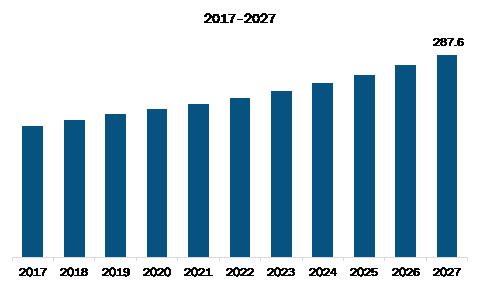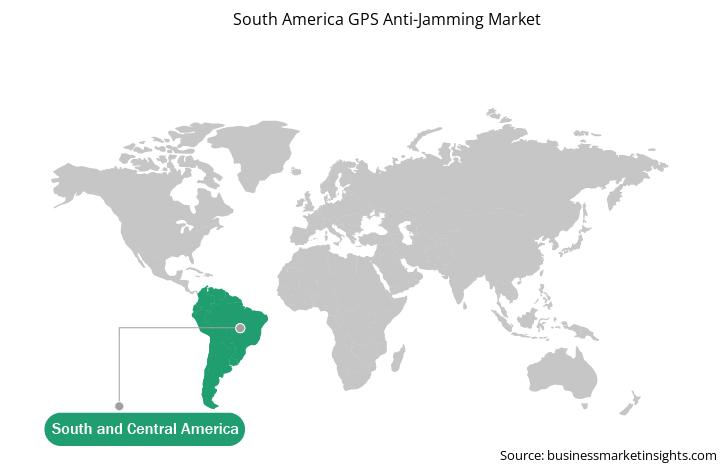The GPS (Global Positioning System) is a monitoring station and satellite network that distributes a signal used for positioning, timing, and navigation operations. The signal is free, reliable, and extremely accurate. By the time the GPS signal reaches the Earth's surface, it is weak and likely to be overcome by higher power radio frequency (RF) energy. An unprotected C/A Code receiver can be interrupted by even a small jammer of ~10 watts of power for ~30 km. GPS anti-jamming protects GPS receivers from malicious, intentional jamming and interference activities. The GPS anti-jamming process uses power minimization to reduce the interference and jamming effect to allow the GPS receiver's proper functioning. The growth of the GPS anti-jamming market in SAM is majorly driven by factors such as the growing implementation of advanced GPS infrastructure and extensive investment in the defense sector. Increasing demand for unnamed airborne vehicles (UAVs) is another factor supporting the SAM GPS anti-jamming market growth. Also other factor such as making of low-cost GPS anti-jamming solutions is also driving the SAM GPS anti-jamming market.
Furthermore, in case of COVID-19, Brazil has the highest number of confirmed cases in SAM region, followed by other countries such as Peru, Columbia, and Argentina. The governments of various countries in SAM are taking several initiatives to contain COVID-19 outbreak in the region through lockdowns, trade bans, and movement restrictions. These measures are expected to have a direct impact on the region’s economic & industrial growth which has affected the SAM GPS anti-jamming market badly. The planned investments in commercial and military sector are also being delayed, which is anticipated to affect the GPS anti-jamming market in the region. The restricted trade movements especially to major trading partners such as China, Europe, and North America is further impacting the export revenues of countries present in this region. In addition to this, the supply chain disruptions and non-availability of raw material/components will also impact the growth of various sectors as well as GPS anti-jamming market players operating in this region. Hence, the decline in business operations and infrastructure investments are expected to directly affect the growth rate of GPS anti-jamming market in this region for the next three to four quarters.

Strategic insights for the South America GPS Anti-Jamming provides data-driven analysis of the industry landscape, including current trends, key players, and regional nuances. These insights offer actionable recommendations, enabling readers to differentiate themselves from competitors by identifying untapped segments or developing unique value propositions. Leveraging data analytics, these insights help industry players anticipate the market shifts, whether investors, manufacturers, or other stakeholders. A future-oriented perspective is essential, helping stakeholders anticipate market shifts and position themselves for long-term success in this dynamic region. Ultimately, effective strategic insights empower readers to make informed decisions that drive profitability and achieve their business objectives within the market.

| Report Attribute | Details |
|---|---|
| Market size in 2019 | US$ 203.9 Million |
| Market Size by 2027 | US$ 287.6 Million |
| Global CAGR (2020 - 2027) | 4.5 % |
| Historical Data | 2017-2018 |
| Forecast period | 2020-2027 |
| Segments Covered |
By Receiver Type
|
| Regions and Countries Covered | South and Central America
|
| Market leaders and key company profiles |
The geographic scope of the South America GPS Anti-Jamming refers to the specific areas in which a business operates and competes. Understanding local distinctions, such as diverse consumer preferences (e.g., demand for specific plug types or battery backup durations), varying economic conditions, and regulatory environments, is crucial for tailoring strategies to specific markets. Businesses can expand their reach by identifying underserved areas or adapting their offerings to meet local demands. A clear market focus allows for more effective resource allocation, targeted marketing campaigns, and better positioning against local competitors, ultimately driving growth in those targeted areas.

The SAM GPS anti-jamming market is expected to grow from US$ 203.9 million in 2019 to US$ 287.6 million by 2027; it is estimated to grow at a CAGR of 4.5 % from 2020 to 2027. The manufacturing of low-cost GPS anti-jamming solutions is one of the prime drivers of the SAM GPS anti-jamming market growth. These solutions are affordable for small businesses. Numerous market players across SAM are coming forward to offer innovative low-cost products; in October 2017, GPSdome Ltd., introduced GPSdome 1.0 Model T, its new product that provides anti-jamming protection for GPS-based timing systems. The company has tested integrated GPSdome-T with popular timing servers such as the MicrosemiSyncServer S650. The cyber-jamming protection solution is used to protect UAVs, autonomous vehicles, and timing systems. Its affordable price gives it an edge over other existing high-cost solutions that have been designed for military applications. So the demand of low-cost GPS anti-jamming solutions is expected to remain high due to its affordability, which will drive the SAM GPS anti-jamming market.
In terms of receiver type, the military & government grade segment accounted for the largest share of the SAM GPS anti-jamming market in 2019. In terms of anti-jamming technique, the nulling technique segment held a larger market share of the SAM GPS anti-jamming market in 2019. Similarly, in terms of application, the surveillance and reconnaissance segment held a larger market share of the SAM GPS anti-jamming market in 2019. Further, the military segment held a larger share of the SAM GPS anti-jamming market based on end user in 2019.
A few major primary and secondary sources referred to for preparing this report on the SAM GPS anti-jamming market are company websites, annual reports, financial reports, national government documents, and statistical database, among others. Major companies listed in the report are BAE SYSTEMS PLC; FURUNO ELECTRIC CO., LTD.; infiniDome Ltd.; L3HARRIS Technologies, Inc.; Lockheed Martin Corporation; NovAtel Inc.; Raytheon Technologies; Thales Group.
The South America GPS Anti-Jamming Market is valued at US$ 203.9 Million in 2019, it is projected to reach US$ 287.6 Million by 2027.
As per our report South America GPS Anti-Jamming Market, the market size is valued at US$ 203.9 Million in 2019, projecting it to reach US$ 287.6 Million by 2027. This translates to a CAGR of approximately 4.5 % during the forecast period.
The South America GPS Anti-Jamming Market report typically cover these key segments-
The historic period, base year, and forecast period can vary slightly depending on the specific market research report. However, for the South America GPS Anti-Jamming Market report:
The South America GPS Anti-Jamming Market is populated by several key players, each contributing to its growth and innovation. Some of the major players include:
The South America GPS Anti-Jamming Market report is valuable for diverse stakeholders, including:
Essentially, anyone involved in or considering involvement in the South America GPS Anti-Jamming Market value chain can benefit from the information contained in a comprehensive market report.